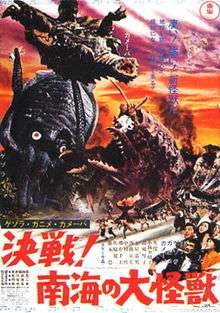Space Amoeba
Space Amoeba (ゲゾラ・ガニメ・カメーバ 決戦! 南海の大怪獣, Gezora, Ganime, Kamēba: Kessen! Nankai no Daikaijū, lit. "Gezora, Ganimes, and Kamoebas: Decisive Battle! Giant Monsters of the South Seas"), is a 1970 Japanese kaiju film directed by Ishirō Honda, written by Ei Ogawa, and produced by Tomoyuki Tanaka and Fumio Tanaka, with special effects by Sadamasa Arikawa.[1] Produced and distributed by Toho Studios, the film stars Akira Kubo, Atsuko Takahashi, Yukiko Kobayashi, Kenji Sahara, Yoshio Tsuchiya, and Yu Fujiki, with Haruo Nakajima portraying both Gezora and Ganimes.
| Space Amoeba | |
|---|---|
 Theatrical release poster | |
| Directed by | Ishirō Honda |
| Produced by |
|
| Screenplay by | Ei Ogawa[1] |
| Starring |
|
| Narrated by | Ichiro Murakoshi |
| Music by | Akira Ifukube[1] |
| Cinematography | Taiichi Kankura[1] |
| Edited by | Masahisa Himi[1] |
Production company | |
| Distributed by | Toho |
Release date |
|
Running time | 84 minutes[2] |
| Country | Japan |
| Language | Japanese |
Space Amoeba tells the story of amoeba-like extraterrestrials that hijack a space probe and, after crash landing on an atoll in the Pacific Ocean, create gigantic monsters from native lifeforms (a kisslip cuttlefish, stone crab and mata mata) for the purpose of conquering the Earth. The film was released theatrically in Japan on 1 August 1970, and received a theatrical release in the United States in 1971 by American International Pictures, under the title Yog-Monster From Space.
Plot
The Helios 7 space probe is sent on a mission to study the planet Jupiter. While on its outward journey to the gas giant, the probe is overtaken by the Space Amoeba, an amorphous parasitic extraterrestrial. The probe returns to Earth and crashes into the South Pacific, where the Amoeba leaves the device and inhabits the body of a cuttlefish, causing it to mutate into what is called "Gezora". The tentacled kaiju begins attacking ships and islands in the area.
A photographer named Kudo and his entourage land on Selgio Island for a photoshoot, but their camp is attacked by Gezora. Because of its mutation, the creature can create extremely cold temperatures with its body. When the survivors discover that Gezora is vulnerable to high temperatures, Kudo and his friends use a leftover Japanese World War II munitions bunker to set fire to the monster. Severely burned, the creature retreats to the water, where it dies.
Later, the Space Amoeba possesses a stone crab, mutating it into "Ganimes" and attacks the surrounding islands. Luckily the humans manage to lure Ganimes into a pit and destroy it with explosives. The Amoeba survives a second time and flees into the surrounding jungles, plotting its revenge.
The Space Amoeba decides to control two Earth creatures this time: another Ganimes and a mata mata named "Kamoebas". The two monsters raid the human camp. Luckily Kudo realizes the two monsters' weakness: supersonic waves. By releasing a storm of bats, the Amoeba loses control of its creations. Ganimes and Kamoebas, no longer under control, go berserk and begin to battle between them. The humans, using more explosives, cause the volcano to erupt, engulfing the Space Amoeba and the two monsters.
Cast
Source:[2]
- Akira Kubo as Taro Kudo
- Atsuko Takahashi as Ayako Hoshino
- Yukiko Kobayashi as Saki
- Kenji Sahara as Makoto Obata
- Yoshio Tsuchiya as Dr. Kyouichi Miya
- Yu Fujiki as the promotion division manager
- Noritake Saito as Rico
- Yuko Sugihara as Stewardess
- Sachio Sakai as the magazine editor
- Chotaro Togin as Engineer Yokoyama
- Wataru Omae as Sakura
- Haruo Nakajima as Gezora / Ganime
- Haruyoshi Nakamura as Kamoebas
- Ichiro Murakoshi as Yog
- Tetsu Nakamura as supplicator Ombo
Release
Space Amoeba was released in Japan on 1 August 1970 where it was distributed by Toho.[2] The film was released theatrically in the United States as Yog-Monster From Space in 1971.[2] The film was distributed by American International Pictures with an English-language dub and had a running time of 81 minutes.[2]
The film was released to home video in 2006 as Space Amoeba in its Japanese language with English subtitles.[2]
References
Footnotes
- Galbraith IV 2008, p. 268.
- Galbraith IV 2008, p. 269.
Sources
- Galbraith IV, Stuart (2008). The Toho Studios Story: A History and Complete Filmography. Scarecrow Press. ISBN 1461673747.CS1 maint: ref=harv (link)
External links
| Wikiquote has quotations related to: Space Amoeba |
- Space Amoeba on IMDb
- Space Amoeba at tohokingdom.com